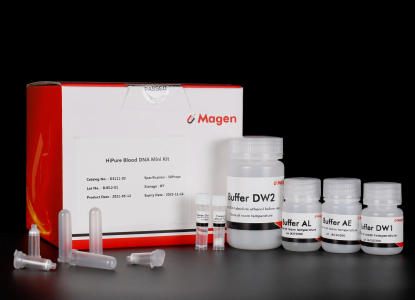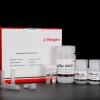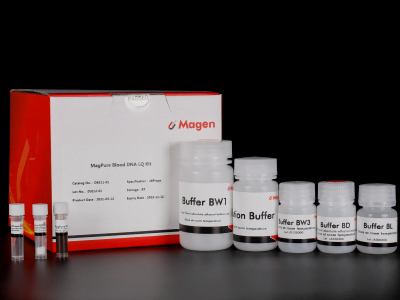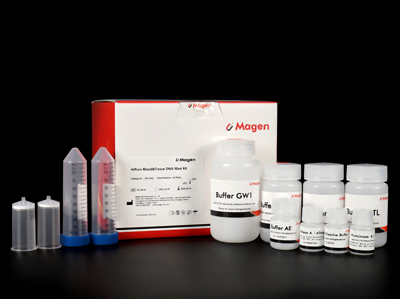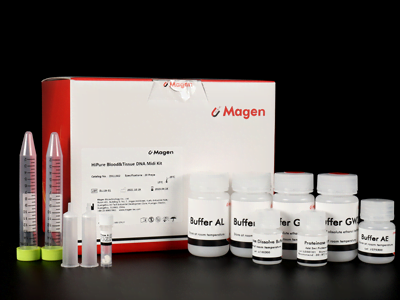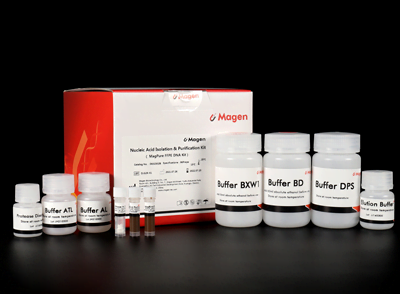Introducción
Blood is a valuable source of DNA for various clinical applications and research studies. Sin embargo, extracting DNA from blood samples presents several challenges:
Safety Concerns:
- Blood samples can harbor pathogens, posing a risk of infection to researchers and contaminating the lab environment.
- Traditional methods often involve hazardous chemicals like phenol-chloroform.
DNA Loss:
- Removing red blood cells, a common pre-treatment step can lead to the loss of desired DNA fractions like viral DNA, circulating DNA, and microbial DNA.
Impurities and Inhibitors:
- Blood contains various components that can interfere with downstream analyses like PCR y transferencia Southern.
New Technology for Improved Blood DNA Extraction:
This product offers a novel approach to address these challenges:
- Safe and Efficient: The method eliminates the need for red blood cell removal, minimizing infectious waste and potential contamination.
- Comprehensive DNA Recovery: The protocol allows for the purification of total DNA, including genomic, mitocondrial, viral, and circulating DNA, providing a more complete picture for analysis.
- Broad Sample Compatibility: The method effectively purifies DNA from various blood components like whole blood (fresh or frozen), plasma, suero, capa leucocitaria, y más.
- Downstream Applications: The extracted high-quality DNA is suitable for reliable PCR and Southern blotting analyses.
This innovative solution simplifies blood DNA extraction while ensuring safety, eficiencia, and comprehensive DNA recovery. It represents a significant advancement for researchers working in various fields like diagnostics, forense, and medical research.
Especificaciones
| Características | Especificaciones |
| Funciones principales | Isolation total DNA from 200ul Whole Blood |
| Aplicaciones | PCR, Detección de virus y pernos del sur., etc. |
| Método de purificación | Mini columna de giro |
| Tecnología de purificación | tecnología de sílice |
| método de proceso | Manual (centrifugación o vacío) |
| Tipo de ejemplo | Whole Blood (fresh or frozen), suero, plasma, leche, saliva, y otras muestras líquidas y células cultivadas |
| Cantidad de muestra | <200μl whole blood or other liquid samples, <5*106 lymphocytes or Culture Cells Non-mammalian animals that have a nucleus in red blood cells (rich in DNA, such as birds and fish): 5~20μl whole blood at a time. |
| Volumen de elución | ≥20μl |
| Tiempo por carrera | ≤30 minutos |
| Volumen de transporte de líquido por columna | 800l |
| Rendimiento de unión de la columna | 100µg |
Principio
Efficient DNA Purification with Silica Column Technology
This product utilizes a silica column-based method for rapid and efficient DNA purification. Here’s a breakdown of the process:
- Sample Lysis and Digestion: The sample is treated with a lysate solution and protease to break down cell membranes and degrade proteins. This releases DNA into the solution.
- Binding to Silica Membrane: The lysate containing the DNA is transferred to a silica column. The silica membrane in the column specifically binds DNA molecules through favorable interactions. Proteins and other impurities remain unbound.
- Washing: Wash buffers are passed through the column, removing unbound proteins and cellular debris that did not adhere to the silica membrane.
- Elution: Finally, a low-salt buffer (typically 10 mM Tris, pH 9.0, y 0.5 mM EDTA) is used to elute the purified DNA from the silica membrane. This buffer disrupts the interaction between DNA and the silica, allowing the purified DNA to be collected in a separate tube.
Ventajas
- High-quality DNA – meets a variety of downstream applications, incluyendo PCR, qPCR, digestión enzimática, hibridación, etc..
- Rápido – sin separación de leucocitos, organic extraction, or ethanol precipitation
- Simple – Todos los ácidos nucleicos se pueden obtener por digestión directa.
- Amplia aplicabilidad- Manejar una variedad de muestras líquidas.
Contenido del kit
| Contenido | D311102 | D311103 |
| Tiempos de purificación | 50 | 250 |
| Minicolumnas HiPure DNA I | 50 | 2 X 125 |
| 2Tubos de recolección de ml | 100 | 5 X 100 |
| Amortiguador AL | 15 ml | 60 ml |
| Memoria intermedia DW1 | 30 ml | 150 ml |
| Tampón GW2* | 12 ml | 50 ml |
| Proteinasa K | 24 mg | 120 mg |
| Tampón de disolución de proteasa | 1.8 ml | 10 ml |
| AE de búfer | 15 ml | 60 ml |
Almacenamiento y estabilidad
For optimal performance:
- Store Proteinase K at 2-8°C (refrigerator) upon arrival.
Acceptable short-term storage:
- Proteinase K can be stored for up to 12 weeks at room temperature (15-25°C) without affecting its performance.
Remaining kit components:
- Store all other components of the kit dry at room temperature (15-25°C).
- They are stable for at least 18 meses en estas condiciones.
Nota importante:
- If storing the entire kit at room temperature, ensure buffers are redissolved before use and always warm all buffers to room temperature before using them.
